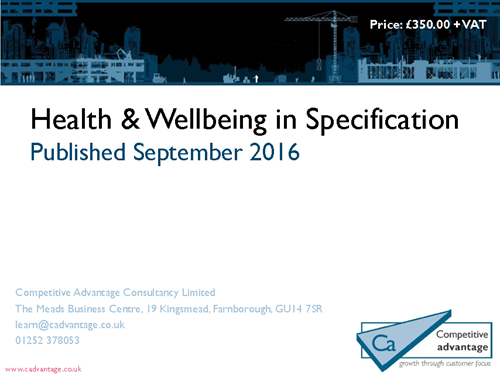Designing for Health & Wellbeing: New research explores opportunity in specification
Designing buildings with the Health & Wellbeing of occupants in mind, is moving up the agenda. New research launched during World Green Building Week, explores the issues of importance to Architects when specifying to meet Health & Wellbeing criteria. With findings highlighting the need for manufacturers to provide the Architect with more information about how their products can contribute to Health & Wellbeing design criteria.
Productivity improvements of between 8% and 11% can be achieved by providing the right working environment. And with staff costs typically representing 90% of business operating costs Health & Wellbeing is moving up the agenda. Significant improvements in learning, in recovery from illness and even higher retail sales can also be seen when incorporating Health & Wellbeing into building design.
The UK government first measured Health & Wellbeing amongst the population in 2012 and now publishes an annual report Measuring National Well-being. The UK Green Building Council (UKGBC) has interpreted Health & Wellbeing to include social, psychological and physical factors. BREEAM also includes measures for Health & Wellbeing for both commercial and residential (Home Quality Mark) buildings.
Architects are now designing to achieve Health & Wellbeing but just how are they approaching this?
New research launched during World Green Building Week, explores the issues of importance to Architects when specifying to meet Health & Wellbeing criteria. The research, conducted by Competitive Advantage Consultancy Ltd, aims to help the manufacturer understand specification influences. The report also includes a summary of Health & Wellbeing issues to help those new to the concept.
150 Architects were interviewed, providing insight into how they are designing to achieve Health & Wellbeing in buildings. What are the influences on product specification? Which sources of information are Architects using? In which sectors is Health & Wellbeing design being used for?
The report found that Architects think they understand the issues around Health & Wellbeing but may not be as informed as they think. It highlighted the need for manufacturers to provide the Architect with more information about how their products can contribute to Health & Wellbeing design criteria. Providing building product manufacturers with the opportunity to promote the benefits of their products in achieving Health & Wellbeing design objectives.
Editors Notes:
More about the Health & Wellbeing in Specification research:
The objectives of the report are to:
- provide an overview of the role of Health & Wellbeing in design
- provide insight into the influence of Health & Wellbeing on product selection
- show levels of usage of Health & Wellbeing across construction sectors
- provide guidance on the key elements of Health & Wellbeing that are used in design
- identify the key decision makers when including Health & Wellbeing in design
The report costs £350 + VAT and is available to purchase online at www.cadvantage-knowledge.co.uk
Architects were asked how likely they would be to select the following product types to contribute to their health and wellbeing designs:
- Windows and facades
- Heating, cooling, ventilation and air conditioning
- Lighting
- Solar shading and control
- Insulation and sound control
- Ceilings, rooflights and roof windows
- Drainage and water supply
- Wall, floor and ceiling colours
- Sanitary fittings
- Wall, floor and ceiling finishes
- Fittings and furniture
The report was compiled in September 2016 by Competitive Advantage Consultancy Ltd. 150 Architects shown in the Barbour ABI database as working on projects for social housing, retail, offices, education and healthcare were surveyed via telephone. The report comprises of 25 pages with 23 charts and tables of data. The report also contains desk research and where possible, web links have been included to allow the reader to go to original sources or gather further information.
